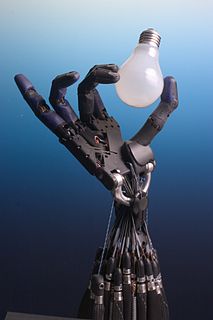Related Research Articles
A humanoid robot is a robot with its body shape built to resemble the human body. The design may be for functional purposes, such as interacting with human tools and environments, for experimental purposes, such as the study of bipedal locomotion, or for other purposes. In general, humanoid robots have a torso, a head, two arms, and two legs, though some forms of humanoid robots may model only part of the body, for example, from the waist up. Some humanoid robots also have heads designed to replicate human facial features such as eyes and mouths. Androids are humanoid robots built to aesthetically resemble humans.

ASIMO is a humanoid robot created by Honda in 2000. It is currently displayed in the Miraikan museum in Tokyo, Japan. On July 8, 2018, Honda posted the last update of Asimo through their official page stating that it would be ceasing all development and production of Asimo robots in order to focus on more practical applications using the technology developed through Asimo’s lifespan. The name was chosen in honor of Isaac Asimov.
Domo is an experimental robot made by MIT designed to interact with humans. The brainchild of Jeff Weber and Aaron Edsinger, cofounders of Meka Robotics, its name comes from the Japanese phrase for "thank you very much", domo arigato, as well as the Styx song, "Mr. Roboto". The Domo project was originally funded by NASA, and has now been joined by Toyota in funding robot's development.

A robonaut is a humanoid robot, part of a development project conducted by the Dexterous Robotics Laboratory at NASA's Lyndon B. Johnson Space Center (JSC) in Houston, Texas. Robonaut differs from other current space-faring robots in that, while most current space robotic systems are designed to move large objects, Robonaut's tasks require more dexterity.

FANUC is a Japanese group of companies that provide automation products and services such as robotics and computer numerical control wireless systems. These companies are principally FANUC Corporation of Japan, Fanuc America Corporation of Rochester Hills, Michigan, USA, and FANUC Europe Corporation S.A. of Luxembourg.

A robot competition is an event where the abilities and characteristics of robots may be tested and assessed. Usually they have to beat other robots in order to become the best one. Many competitions are for schools but several competitions with professional and hobbyist participants are also arising.

The P series is a chronological progression of prototype humanoid robots as developed by Honda. The research conducted allowed the eventual creation of ASIMO. Honda decided on making a humanoid robot, "ASIMO," the world's most advanced humanoid robot of its time. Honda Motor's President and CEO Hiroyuki Yoshino, at the time, described Honda's humanoid robotics program as consistent with its direction to enhance human mobility.

iCub is a 1 metre tall open source robotics humanoid robot testbed for research into human cognition and artificial intelligence.

A ball balancing robot also known as a ballbot is a dynamically-stable mobile robot designed to balance on a single spherical wheel. Through its single contact point with the ground, a ballbot is omnidirectional and thus exceptionally agile, maneuverable and organic in motion compared to other ground vehicles. Its dynamic stability enables improved navigability in narrow, crowded and dynamic environments. The ballbot works on the same principle as that of an inverted pendulum.
In computer science, programming by demonstration (PbD) is an end-user development technique for teaching a computer or a robot new behaviors by demonstrating the task to transfer directly instead of programming it through machine commands.
PLEN is a small desktop toy humanoid robot that can replicate complex human movements. It is controlled remotely by use of a Bluetooth enabled phone. When programmed, it is able to use a skateboard, rollerskates, pick up, kick and throw small things, and stand up if he tumbles to the floor. It does not feature any sensors or automatic software reactions to certain events, as it is entirely remote-controlled.
The Humanoid Robotics Project (HRP) is a project for development of general domestic helper robots, sponsored by Japan's Ministry of Economy, Trade and Industry (METI) and New Energy and Industrial Technology Development Organization (NEDO), spearheaded by Kawada Industries and supported by the National Institute of Advanced Industrial Science and Technology (AIST) and Kawasaki Heavy Industries, Inc. The HRP series also goes by the name Promet. The HRP should not be confused with the HOAP series, which is manufactured by Fujitsu.
Tomotaka Takahashi, roboticist and founder of Kyoto University's ROBO-GARAGE since 2018, creates humanoid robots known for their smooth, fluid motions and sleek appearance. Creating a number of humanoid robots entirely by himself, from concept through to production, Takahashi's designs have been featured in art exhibitions celebrating the creation of Astroboy, Time Magazine's Coolest Inventions of 2004, and promotions for Bandai, Panasonic, and Pepsi. He has also worked with toy companies to produce relatively inexpensive robots for the hobby market, including those for Kyosho.

Robotics is an interdisciplinary research area at the interface of computer science and engineering. Robotics involves design, construction, operation, and use of robots. The goal of robotics is to design intelligent machines that can help and assist humans in their day-to-day lives and keep everyone safe. Robotics draws on the achievement of information engineering, computer engineering, mechanical engineering, electronic engineering and others.
The following outline is provided as an overview of and topical guide to robotics:

The RoboCup 3D Simulated Soccer League allows software agents to control humanoid robots to compete against one another in a realistic simulation of the rules and physics of a game of soccer. The platform strives to reproduce the software programming challenges faced when building real physical robots for this purpose. In doing so, it helps research towards the RoboCup Federation's goal of developing a team of fully autonomous humanoid robots that can win against the human world soccer champion team in 2050.

A domestic robot is a type of service robot, an autonomous robot that is primarily used for household chores, but may also be used for education, entertainment or therapy. Thus far, there are only a few limited models, though speculators, such as Bill Gates, have suggested that they could become more common in the future. While most domestic robots are simplistic, some are connected to WiFi home networks or smart environments and are autonomous to a high degree. There were an estimated 16.3 million service robots in 2018.

DARwIn-OP is a miniature-humanoid robot platform developed and manufactured by Korean robot manufacturer Robotis in collaboration with Virginia Tech, Purdue University, and University of Pennsylvania. It is also supported by a $1.2 million NSF grant. DARwIn-OP has twenty degrees of freedom, each controlled by a DYNAMIXEL MX-28T servo motor.
A juggling robot is a robot designed to be able to successfully carry out bounce or toss juggling. Robots capable of juggling are designed and built both to increase and test understanding and theories of human movement, juggling, and robotics. Juggling robots may include sensors to guide arm/hand movement or may rely on physical methods such as tracks or funnels to guide prop movement. Since true juggling requires more props than hands, many robots described as capable of juggling are not.

Aude G. Billard is a Swiss physicist and pioneer in the fields of machine learning and human-robot interactions. As a full professor at the School of Engineering at Swiss Federal Institute of Technology in Lausanne (EPFL), Billard’s research focuses on applying machine learning to support robot learning through human guidance. Billard’s work on human-robot interactions has been recognized numerous times by the Institute of Electrical and Electronics Engineers (IEEE) and she holds currently holds a leadership position on the executive committee of the IEEE Robotics and Automation Society (RAS) as the vice president of publication activities.
References
- ↑ Archived June 16, 2008, at the Wayback Machine
- ↑ "Miniature Hunamoid Rrobot HOAP-3" (PDF). Fujitsu. Archived from the original (PDF) on 2012-10-24. Retrieved 2011-06-14.
- ↑ Archived September 30, 2011, at the Wayback Machine
- ↑ "HOAP-2 learns to walk through imitation video on YouTube" . Retrieved 19 March 2011.
- ↑ "HOAP-2 performs sumo movements video on YouTube" . Retrieved 19 March 2011.
- ↑ Kormushev, Petar; Nenchev D.N.; Calinon S.; Caldwell D.G. Upper-body Kinesthetic Teaching of a Free-standing Humanoid Robot (PDF). IEEE International Conference on Robotics and Automation (ICRA 2011). Retrieved 19 March 2011.
- ↑ "HOAP-2 robot learns to clean a whiteboard video on YouTube" . Retrieved 19 March 2011.
- ↑ "HOAP-2 follows a ball video on YouTube" . Retrieved 19 March 2011.
